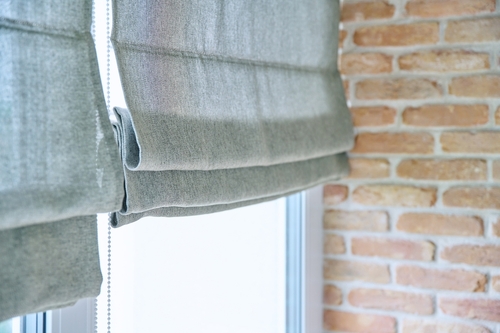
Choosing the Right Fabric for Roller Blinds: Factors to Consider. Roller blinds play a pivotal role in enhancing both the aesthetic appeal and functionality of homes.
With the myriad of fabric choices available, selecting the ideal material for roller blinds can significantly impact the ambiance and comfort of your living spaces.
This article delves into the essential factors homeowners should consider when choosing roller blind fabrics, ensuring an informed decision that marries style with practicality.
Understanding Roller Blinds
Roller blinds are favored for their sleek design and ease of use, offering a streamlined look that complements modern interiors.
The choice of fabric is crucial, affecting everything from light filtration to durability, and thus plays a central role in a roller blind’s effectiveness and overall appeal.
Key Factors in Choosing Roller Blind Fabric
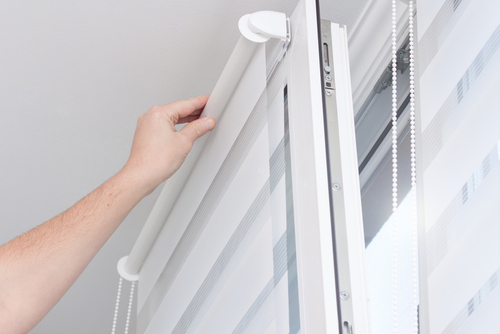
Light Filtering Capabilities
- Transparent: Allows the most light in, suitable for living areas where natural light is desired.
- Translucent: Provides privacy while still letting in light; ideal for bathrooms and kitchens.
- Blackout: Blocks out light completely, perfect for bedrooms and media rooms.
Selecting the right opacity depends on the specific needs of each room, balancing natural light with privacy requirements.
Durability and Material Quality
The longevity of roller blinds is significantly influenced by fabric durability. Synthetic fabrics, such as polyester, offer resilience and easy maintenance, while natural fabrics, like cotton and linen, provide a classic aesthetic but may require more care to prevent fading and wear.
Style and Aesthetics
Fabric choice dramatically influences the room’s visual impact. Current trends in Singapore lean towards minimalist designs, with neutral colors and subtle patterns gaining popularity.
However, vibrant colors and bold prints can serve as statement pieces in an otherwise understated room.
Energy Efficiency and Insulation
Fabrics play a crucial role in thermal insulation, contributing to energy savings by keeping homes cooler.
Fabrics with thermal backing or those designed for insulation can help achieve better energy efficiency.
Safety and Health Considerations
Opting for non-toxic, fire-retardant fabrics is crucial for ensuring safety.
For households with allergy sufferers, hypoallergenic materials can make a significant difference in indoor air quality and overall comfort.
Maintenance and Ease of Cleaning
The ease of maintaining roller blind fabrics varies, with some materials requiring simple dusting or wipe-downs and others needing more specialized care.
Understanding the cleaning requirements will help maintain the fabric’s appearance and functionality over time.
Popular Roller Blind Fabric Types
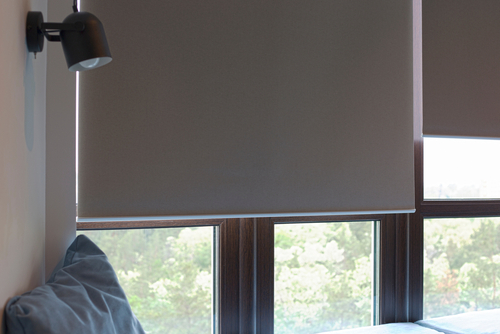
Polyester Fabrics
Known for their durability and ease of maintenance, polyester fabrics come in a wide range of designs and textures, making them a versatile choice for various home styles.
Cotton and Linen Fabrics
These natural fabrics offer a timeless look and feel but may be more prone to fading and require gentle cleaning methods to preserve their appearance.
PVC and Vinyl Fabrics
Ideal for areas exposed to moisture or where easy cleanup is needed, PVC and vinyl fabrics are waterproof and resilient, suitable for kitchens and bathrooms.
Solar Screen Fabrics
Designed to reduce UV exposure and glare, solar screen fabrics protect interior furnishings from sun damage while conserving energy, making them a practical option for sunny locales.
Eco-Friendly and Sustainable Fabrics
For environmentally conscious homeowners, options like recycled polyester or organic cotton offer a way to reduce environmental impact without compromising on style or functionality.
Considering the Singapore Climate
Singapore’s humid and sunny climate necessitates fabrics that can withstand moisture and resist sun damage.
Materials that offer mold and fade resistance are particularly valuable in maintaining the longevity and appearance of roller blinds in tropical settings.
Installation and Measurement Tips
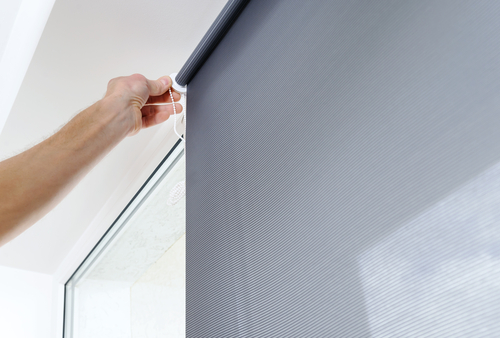
Accurate measuring is key to achieving the desired look and functionality.
While DIY installation is possible, professional assistance can ensure precise fitting and trouble-free operation, especially for custom or complex window shapes.
Overcoming Common Selection Challenges
Choosing the right fabric involves navigating between functionality, aesthetics, and budget constraints.
Understanding the specific benefits and limitations of each fabric type can help address common pitfalls, ensuring a choice that meets all criteria.
Frequently Asked Questions
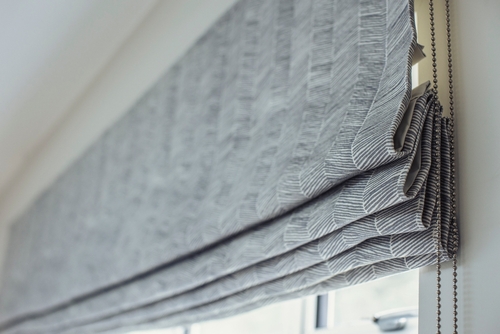
1. How do I choose between blackout and translucent fabrics for my bedroom?
The choice between blackout and translucent fabrics depends on your specific needs for sleep comfort and privacy.
If you require complete darkness to achieve a restful sleep or if your bedroom faces the sunrise, blackout fabrics are ideal as they can significantly reduce light penetration.
On the other hand, if you prefer natural light to gently wake you in the morning while still maintaining privacy, translucent fabrics are a better choice.
They diffuse light, softening the room’s ambiance without fully darkening it. Consider your personal sleep habits and the direction your windows face when making a decision.
2. Can the fabric of roller blinds be replaced without changing the entire system?
Yes, in many cases, the fabric of roller blinds can be replaced without the need to change the entire system.
This is particularly true for roller blinds designed with a replaceable fabric feature, allowing you to update the look or functionality of your blinds without a complete overhaul.
However, this capability varies by manufacturer and design, so it’s essential to consult with your supplier or a professional installer to understand your specific roller blind system’s flexibility.
3. How does the choice of fabric affect the overall cost of roller blinds?
The choice of fabric can significantly impact the cost of roller blinds, with prices varying according to the type of material, its quality, and any special features (such as thermal insulation, UV protection, or designer patterns).
Generally, synthetic fabrics like polyester are more cost-effective and offer a wide range of styles and patterns. In contrast, natural fabrics like linen or specialized materials with added functionalities (e.g., blackout or solar protection) tend to be priced higher due to their additional benefits and manufacturing processes.
Balancing your budget with your needs and preferences is key to selecting the right fabric.
4. What fabric options are considered child-safe for roller blinds?
Child-safe fabrics for roller blinds are those that are non-toxic and free from harmful chemicals.
Consider roller blinds that operate without cords or with safety features, such as breakaway connectors or cord tensioners, to eliminate the risk of accidents.
Safety should always be a priority in homes with young children.
5. How frequently should roller blind fabrics be cleaned for optimal longevity?
The cleaning frequency for roller blind fabrics depends on the fabric type, the room’s usage, and exposure to dust and dirt.
As a general guideline, dusting or vacuuming with a soft brush attachment every few months can help maintain the fabric’s appearance and prevent dust accumulation.
Stains or spots should be gently cleaned with a damp cloth and mild detergent as soon as they occur to prevent setting.
Some fabrics may have specific cleaning instructions based on their material and finish, so it’s important to refer to the manufacturer’s recommendations.
Regular maintenance can significantly extend the life and beauty of your roller blinds.
Choosing the Right Fabric for Roller Blinds: Factors to Consider – Conclusion
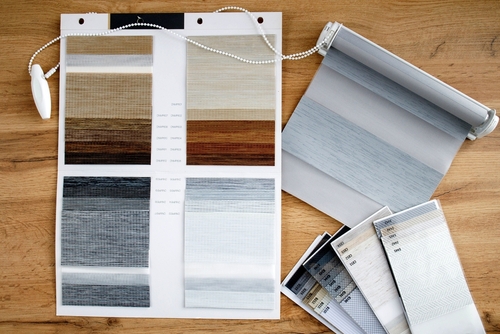
Selecting the right fabric for roller blinds is a crucial decision that impacts not only the visual appeal of your home but also its functionality and comfort.
By considering factors such as light control, durability, style, and energy efficiency, homeowners can find the perfect balance to enhance their living spaces.
Explore the diverse range of roller blind fabrics suitable for every room and design preference.
Consulting with design professionals and experimenting with fabric samples can provide personalized advice and solutions, ensuring your roller blinds perfectly match your home’s aesthetic and functional needs.
Are you seeking professional and reliable roller blind experts in Singapore? Contact us today!